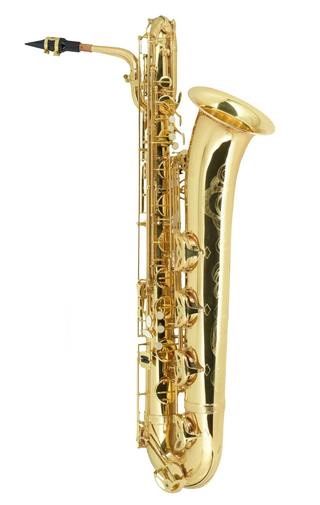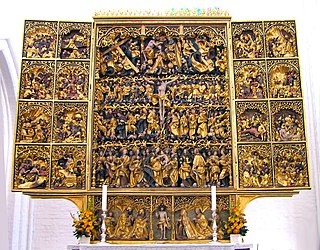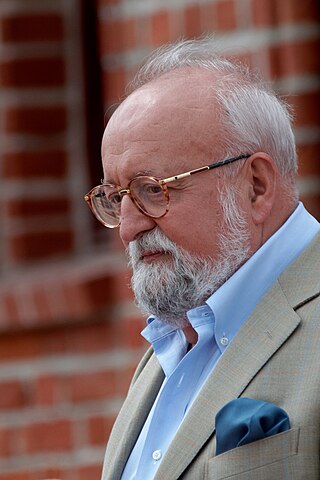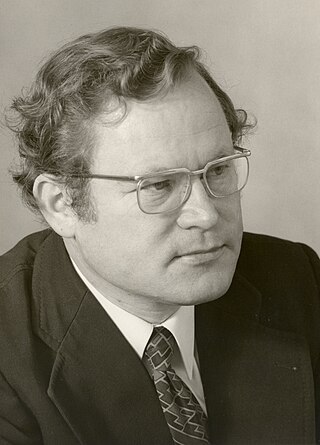
The sarrusophones are a family of metal double reed conical bore woodwind instruments patented and first manufactured by French instrument maker Pierre-Louis Gautrot in 1856. Gautrot named the sarrusophone after French bandmaster Pierre-Auguste Sarrus (1813–1876), whom he credited with the concept of the instrument, though it is not clear whether Sarrus benefited financially. The instruments were intended for military bands, to serve as replacements for oboes and bassoons which at the time lacked the carrying power required for outdoor marching music. Although originally designed as double-reed instruments, single-reed mouthpieces were later developed for use with the larger bass and contrabass sarrusophones.

The baritone saxophone is a member of the saxophone family of instruments, larger than the tenor saxophone, but smaller than the bass. It is the lowest-pitched saxophone in common use - the bass, contrabass and subcontrabass saxophones are relatively uncommon. Like all saxophones, it is a single-reed instrument. It is commonly used in concert bands, chamber music, military bands, big bands, and jazz combos. It can also be found in other ensembles such as rock bands and marching bands. Modern baritone saxophones are pitched in E♭.
Václav Nelhýbel was a Czech American composer, mainly of works for student performers.
Antonio Vivaldi wrote at least three Gloria compositions, settings of the hymn Gloria in excelsis Deo, with words probably dating back to the 4th century, and an integral part of the mass ordinary. Two of them have survived: RV 588 and RV 589. A third, RV 590, is mentioned only in the Kreuzherren catalogue and presumed lost. The RV 589 Gloria is a familiar and popular piece among sacred works by Vivaldi. It was probably written at about the same time as the RV 588, possibly in 1715.

Gioachino Rossini's Petite messe solennelle was written in 1863, possibly at the request of Count Alexis Pillet-Will for his wife Louise to whom it is dedicated. The composer, who had retired from composing operas more than 30 years before, described it as "the last of my péchés de vieillesse".
Christus is an oratorio by the Hungarian composer and pianist Franz Liszt. The oratorio takes the traditional plot of Jesus Christ's life from his birth to his passion and resurrection, using Bible texts, and is thus somewhat reminiscent of another famous religious work, Messiah by George Frideric Handel.
Stabat Mater, FP 148, is a musical setting of the Stabat Mater sequence composed by Francis Poulenc in 1950.

In Christian music, a Passion is a setting of the Passion of Christ. Liturgically, most Passions were intended to be performed as part of church services in the Holy Week.

Krzysztof Penderecki wrote his Seventh Symphony, subtitled "Seven Gates of Jerusalem", in 1996 to commemorate the third millennium of the city of Jerusalem. Originally conceived as an oratorio, this choral symphony was premièred in Jerusalem in January 1997; it was only after the first Polish performance two months later that Penderecki decided to call it a symphony. It is written for two sopranos, alto, tenor, bass, narrator, chorus and orchestra.
Jonathan Alfred Clawson Redford is an American composer, arranger, orchestrator, and conductor. He is also the author of Welcome All Wonders: A Composer's Journey.
Richard Collins St. Clair is an American composer, pedagogue, poet and pianist.

Herbert Blendinger was an Austrian composer and viola player of German origin.
Utrenja, alternatively spelled as Utrenia, Utrenya, or Jutrznia, and sometimes also translated as Matins, is a set of two liturgical compositions by Polish composer Krzysztof Penderecki. They were composed and premiered in 1970 and 1971.

Sankt-Bach-Passion is an oratorio composed by Mauricio Kagel in 1985 for the tricentenary of the birth of Johann Sebastian Bach. It follows the model of Bach's Passions, but the topic is not biblical, rather refers to Bach's biography. The text includes documents such as Bach's letters to patrons, and excerpts from contemporary biographies. The work is an extended oratorio for soloists, choir, and orchestra. It was premiered in Berlin in 1985, conducted by the composer, and recorded shortly afterwards by the same performers.

Credo is a large-scale sacred composition for soloists, children's choir, mixed choir and orchestra by Krzysztof Penderecki, completed in 1998. It was commissioned by Helmuth Rilling for the Oregon Bach Festival, where it was first performed on 11 July 1998. Penderecki expanded the liturgical text by hymns and Bible verses in Latin, Polish and German. A recording won the 2000 Grammy Award for best choral performance.







